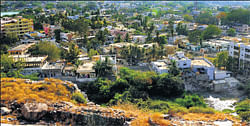
According to a study by the Karnataka State Pollution Control Board (KSPCB), dust levels with chemical and toxic emissions have gone up in mixed urban areas (which have both commercial and residential population) as opposed to the industrial areas in the last five years.
Victoria Hospital which comes under the ‘sensitive zone’ classification, has recorded suspended particulate matter (SPM) levels of 165 microgram per metric cube (µg/M3), while the permissible limits or standard is 70 µg/M3, in 2009-10. The Residual Suspended Particulate Matter (RSPM) is 59 µg/M3, while the standard is 50 µg/M3. In 2008-09, the hospital zone had recorded even higher emission levels, where the RSPM stood at 63 µg/M3, and SPM levels read 201 µg/M3.
Yeshwanthpur limits project a scarier trend. The RSPM is 221 µg/M3 as opposed to the standard 60 µg/M3. The SPM levels last year were 487 µg/M3, against the standard 140 µg/M3. The industrial zones - Whitefield, Peenya and KHB Industrial area in Yelahanka - have all shown a steady decline in pollution levels.
Whitefield which had exceeded the permissible limits in 2008-09 by recording an RSPM of 184 µg/M3 (standard - 120 µg/M3) and SPM of 480 µg/M3 (standard - 360 µg/M3), in 2009-10 it registered an RSPM of 122 µg/M3 and SPM of 288 µg/M3, which is well within the permissible limits.
Peenya Industrial area, which had also crossed the permissible limits in 2008-09 has recorded reduced levels of pollution last year. The RSPM recorded in 2009-10 was 74 µg/M3, while the SPM was 187 µg/M3. The RSPM and SPM levels in KHB Industrial Area in Yelahanka were 56 µg/M3 and 202 µg/M3, respectively.
Green initiatives
The BMTC's initiative, 'Bus Day', has yielded good results, as per the KSPCB's study. The Board has been monitoring the air quality on ‘Bus Day’ on the fourth of every month since February 4, 2010. The studies indicate that there has been 11.3 per cent reduction in pollution levels. While the sulphur di-oxide levels have come down by 13.2 pc; nitrogen oxides by nine pc; respirable suspended particulate matter by 13.3 pc; carbon monoxide by 10.5 pc and ozone or tri-oxygen by 10.6 pc.
The supply of ‘green diesel’ and ‘green petrol’ initiative by the Centre to 11 metros from 1997 onwards has helped in the reduction of sulphur di-oxide levels.
Since the sulphur content is already non-existent in the fuel, the emission is also less polluting. The SO2 concentration has come down from 28 µg/M3 to 14.2 µg/M3.
The KSPCB at its recent meeting decided to set up six more continuous air quality monitoring stations in Bellary, Sandur, Mysore, Mangalore, and Hubli-Dharwad.
The units would be set up each at a cost of Rs one crore, to study nature, quality and quantity of ambient air and emissions at the mining areas where air pollution level is very high, KSPCB's chairman A S Sadashivaiah said.
Presently, there are 35 manual air monitoring stations in the State, 13 of them in Bangalore. So far, only two continuous monitoring stations have been set up in the City.